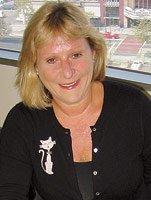Gazing Into Fashion's Future: Searching for the Next Big Trend
Retailers once relied on buying offices to purchase the best new fashion labels, but since the 1980s, buying offices have earned much of their salaries by searching for the elusive holy grail of retailing: the next big trend.
The stakes are high in this quest. A perfect prediction from these buying offices could transform a so-so period of sales into a season of recordbreaking profits. Ignoring a forecast or receiving bad advice could send profits plummeting.
Bad advice is poison to the buying offices, too. The ones doling it out don’t stay in business for long. The offices that have long track records—such as the three big buying offices in the California Market Center in Los Angeles: Bregman & Associates, Barbara Fields Buying Office Inc., and Directives West—have a reputation for giving sound, accurate trend forecasts. That doesn’t mean things are easy for them. These companies, as well as fashion industry watchers such as Ilse Metchek, executive director of the Los Angeles–based California Fashion Association, said the field has became rougher, even for companies with stellar reputations.
“A buying office has to work much harder,” Metchek said. “A proliferation of new labels keeps them on their toes.”
Thanks to the explosion of information on the Internet, anyone can claim to be a fashion expert by surfing the Web, said Sandy Richman, co-owner of Directives West. But, she notes, “It’s not focused—you have to read on forever, and you have to have unlimited time.”
Few in the industry have that luxury. The chiefs of these buying offices stay ahead of the fashion curve by honing their forecasting skills and sharpening their competitive edge.
The Big PictureBarbara Fields Buying Office Inc.suite B1221(213) 627-6474
Barbara Fields paints the big picture in forecasting juniors fashions for her clients. If 2004 was the year of the celebrity, 2005 will be the year when almost anything goes, she predicts.
“One of the biggest trends is customization,” said Fields, who has been in the forecasting business since 1982. “It’s doing your own thing. Nobody wants to look like anybody else.”
Like other trend forecasters, she reached her conclusions by making frequent trips to Europe and New York and reconnaissance trips throughout Los Angeles. She also researches the history of manufacturers to see what they have done in the past, which she said is a decent indicator of what they will do next.
One way she has kept her competitive edge sharp is by increasing her staff. Her London office hired a second analyst last year. She also maintains offices in New York in addition to her Los Angeles headquarters.
For a period during the 1980s, she maintained a staff of more than 20 buyers. These days, her clients prefer forecasts, so her Los Angeles office employs more than 20 assistants to produce the 150,000 color copies each month that make up her monthly European reports and her 39 bimonthly reports on the future of fashion.
The forecasts detail what colors, fabrics and styles retailers will see in stores in one year. In 2003, she said the camisole would be popular in 2004. This year, she forecasts a top with a layered look, called the “crop shrug two-fer,” will be popular in Spring 2005 and rhinestone denim and trims will be key for Fall 2005. She also recommends looking out for preppy styles, such as polo collars and track jackets, and baby-doll tunic tops next year.
The Communicators Directives West suite A1126 (213) 627-5921
Directives West co-owners Sandy Richman and Sandy Potter met the challenge of a more competitive milieu by increasing the depth and breadth of their reportage. “Our biggest strength is communication,” Potter said.
Every Tuesday, they publish their Directives West reports, which feature detailed trend, market and store analyses, as well as information about what people are wearing on the streets in fashion capitals such as London, Tokyo and Los Angeles.
The Directives West co-owners have also broadened the scope of their communications by increasing their coverage of red-hot categories, such as denim, accessories and home deacute;cor.
The foundation of their work has remained unchanged since 1982, the year they founded the office. They base their forecasts on solid fashion reporting from a retail point of view. Potter, Richman and their team of eight analysts globe trot to wherever fashion is breaking, whether it is in Paris shops or fashion-forward neighborhoods in Miami or Los Angeles.
Richman predicted premium denim would become popular when she saw fashionable folk donning denim in Japan five years ago. Last year, she forecast the contemporary market would increase in importance in 2004.
For 2005, Directives West anticipates that tunic tops and skirts, especially woven skirts and those of longer lengths, will be big sellers.
And then there’s the importance of color. “We feel strongly that color will drive the Spring 2005 season,” Potter said.
The California Mission Bregman & Associates suite A793 (213) 452-0033
Call Stuart Berman a pitchman for the West Coast look. “We promote California resources,” said Berman, president of Bregman & Associates. “Our mission is to help retailers become more successful by realizing the potential and importance of California manufacturers.”
Luckily for Berman, California looks—from flip-flops and tank tops to premium denim and luxury sweats—have been at the top of the wish list for fashion-conscious consumers across the United States and the globe.
Berman and his team comb the Golden State’s beaches, stores and nightclubs looking for the next big wave in California fashion. They also conduct focus groups at high schools.
The offices forecast trends through monthly trend analyses, retail shopping reports and man-on-the-street photo packs as well as through weekly photo galleries sent over the Internet.
These reports cover all of California’s apparel market, including contemporary, misses, children’s and swim.
Berman said he believes his company stays competitive through customer service. This service could mean anything from organizing a client’s business trip in the Los Angeles area to presenting new resources and detailed briefings in the Bregman offices.
Because of changing times, Berman has diversified his client base to include specialty stores and the off-price market, although most of the company’s business still comes from traditional department stores. He said 20 percent of the company’s business is buying, which includes doing initial buys with new vendors, reorders and at-once opportunity buys.
“Wovens, jackets and skirts will be major stories,” Berman said of his 2005 forecast. “One big trend will be ’global glam,’ which will emphasize cross-cultural dressing pieces from around the world.”
























